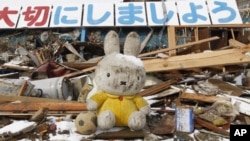Japan’s government says the total cost of the damage caused by the tsunami could reach 25 trillion yen – or U.S. $309 billion.
Reconstruction could boost economy
Entire towns were wiped out when the wave hit on March 11.
Farms, factories, roads, railways and electricity lines were destroyed, while almost half a million people have been made homeless. Despite the destruction, many Japanese people hope the reconstruction effort might turn out to help the Japanese economy.
If the government’s estimate proves correct, it would make the earthquake and tsunami that devastated the northeast coast of Japan one of the costliest natural disasters in history.
The predicted cost – up to US $309 billion – includes the destruction to housing, businesses and infrastructure in the seven worst-hit prefectures. But that may only be part of the story.
Tokyo is the beating heart of the world’s third-largest economy. This global financial hub is enduring rolling blackouts because of damage to the Fukushima nuclear power plant. The business costs of the power disruptions are not counted in this estimate.
All facets' of economic life affected
Former Japanese finance minister Makoto Utsumi – now president of the Japan Credit Rating Agency – says the coming months will be tough.
“As far as the short term is concerned, of course we have a serious challenge before us,” Utsumi said. “So probably we would suffer one, two or three quarters of negative growth. But in the long term I believe this will be good for the Japanese economy, through the active reconstruction, the stimulus for the economy, would push up our growth for the coming 3 or 4 years.”
The tsunami's aftermath is affecting every facet of economic life.
Tokyo’s Tsukiji-shijo is one of the largest fish and vegetable markets in the world. Every day tens of thousands of tons of produce from Japan and around the world are traded in these vast warehouses.
The United States and several other countries have banned some Japanese produce imports because of concerns about possible contamination from the nuclear plant.
Stallholders here worry that there could be far wider consequences for their businesses.
“It’s not just Fukushima. Other places like Chiba [next to Tokyo] and other prefectures are affected by the radiation, places where I do business. I’m really worried.”
International companies fleeing Tokyo
On the edge of the market, Hiro Masamoto runs a knife store catering to the fish traders. He is concerned about the future.
“I am worried. I don’t think we’ve seen the full effects yet. If customers stop coming, we’ll be in real trouble.”
Japan’s famous bullet trains are once again running from the capital to the tsunami-hit Tohoku region. Freeways heading north are opening up again to normal traffic.
But many international companies have moved staff out of Tokyo, fearing a potential catastrophe at the Fukushima nuclear plant. Countless seminars, meetings and events have been cancelled. Tourist numbers have plummeted.
Sun will rise again
Growth remains weak – Japan’s economy only recently emerged from recession, in 2009.
But former Japanese Finance Minister Makoto Utsumi insists this sun will rise once more for the Japanese economy.
“For the reconstruction of our economy, not only regional reconstruction but national reconstruction, I think we have money, we have know-how, we have technology, capability, and we have the courage to face these difficulties and finally we will succeed in making the region and the country brilliant again,” Utsumi said.
Like Utsumi, many Japanese are determined that their country can repeat the economic miracle of the 1980s – this time turning catastrophe into growth.
With an estimated 25,000 people dead or missing, the human cost of the disaster is tragically clear.
It will be many months, if not years before the full extent of the damage to Japan’s economy is known.















